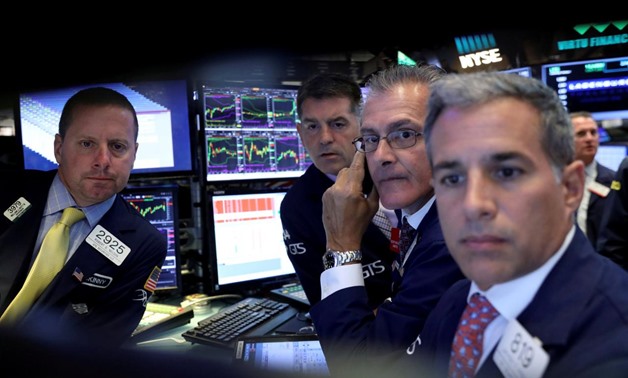
FILE PHOTO: A screen displays trading information for German insurance firm Allianz on the floor of the New York Stock Exchange (NYSE) in New York, U.S., July 19, 2017.
Brendan McDermid/File Photo
LONDON/NEW YORK - 25 August 2017: Investors have been piling into currency-hedged equity tracker funds, seeking protection against big moves in foreign exchange rates.
Typically foreign investors buy un-hedged equities since share prices are usually negatively correlated to currencies. In fact, they offer a partial hedge against sharp moves in foreign exchange.
But with most equity markets near record highs and major currencies notching up double-digit gains or losses this year, investors are taking no chances.
Exchange-traded funds trade like stocks but track a wider range of securities more cheaply than buying the underlying assets. With a currency-hedged ETF, an investor pays an additional cost for hedging the foreign exchange risk, often using currency forwards or options.
“ETFs are becoming a tool also to manage currency,” said Simone Rosti, European head of passive and exchange-traded fund sales at UBS.
Investors poured some $17 billion into currency-hedged equity ETFs globally to the end of July, a sharp turnaround from the $9.1 billion of outflows seen in the same period last year.
Currency-hedged ETFs are relative newcomers and still just a drop in the ocean. They make up just $127 billion of the $3.3 trillion assets under management in equity ETFs as a whole, according to industry group ETFGI.
But their growing importance underlines the impact currency moves can have on portfolio returns.
“The performance of an equity market relative to the global benchmark can be dominated by movements in the country’s currency,” said Mark Richards of JPMorgan Asset Management.
A U.S. investor holding an MSCI Europe tracker, for example, has enjoyed returns of 15.5 percent year-to-date in dollars, while the index has gained just 3.2 percent in euro terms.
FX HEDGES
ETF providers say flows into hedged products often increase just after a big swing in a currency or when market positioning shows a preponderance of investors betting a currency will move in one direction.
For example, the euro has gained more than 12 percent so far this year and is the best performing G10 currency.
Flows into currency-hedged ETFs tracking European equities in 2017 have far outpaced last year as brokers and investors have warned in recent weeks that the euro’s rise could start to threaten the bright outlook for profits of European companies.
In the first seven months of this year investors poured $1.3 billion into these products, compared with $9.2 billion of outflows in the same period last year.
“We’ve started to see many clients moving to euro-hedged products. We see this trend continuing in the next few months,” said UBS’s Rosti.
ETFs hedged to the single currency saw a dramatic increase in inflows in April as concerns around the French election faded. They drew in $638 million that month after managing just $6 million in March.
Similarly, since the pound’s dramatic slide on the day after Britain’s Brexit vote in June 2016, the benchmark UK stock index has hit record highs as the British-based companies with large global footprints benefited from favourable currency translation boosting earnings.
Sterling fell to its lowest against the euro in eight years this week, barring a brief flash crash in October 2016 and analysts say investors are reaching for hedged ETFs to protect against a possible rebound in the pound.
Deutsche Asset Management ETF strategist Eric Wiegand said ETFs hedged against sterling are their best-selling product so far this year.
TURNING FORTUNES
While the cost of hedging foreign equity exposure can be substantial even for relatively low-cost ETFs, amounting to anything between 1 to 2 percent, investors say these products can offer valuable savings especially when markets lean towards consensus views.
For example, at the end of last year, expectations that U.S. President Donald Trump’s fiscal plans would fuel a strong dollar and prompt the Federal Reserve to raise interest rates multiple times were very popular.
But those expectations have been squashed in recent months and bets the greenback will weaken have multiplied.
Inflows into currency-hedged ETFs exposed to the United States also ballooned this year, drawing in $5.9 billion so far – already ahead of the $5.3 billion net inflows for the full year 2016.
“Is this really the time, now that the dollar has moved, that you want to go unhedged? I’d really question that,” said Jeremy Schwartz, director of research at WisdomTree Asset Management, adding U.S. investors should consider protecting against a potential rise in the dollar.
DOUBLE HEDGING
But some remain sceptical about the need for ETFs to hedge currency exposure when large multinational companies run sophisticated treasury operations that use a variety of instruments to protect themselves against currency swings.
"Buying a hedged ETF hedges the currency exposure of companies that are already hedging," wrote Vincent Deluard, head of global macro strategy at INTL FCStone, a brokerage, in a note to clients. "Double-hedging achieves nothing other than generate extra fees and commissions."
Though a hedge can drive outperformance during a currency shock, in the medium to long-term the performance differential between hedged and unhedged ETFs tracking the same index diminishes.
Then there are other asset classes such as fixed income where investors see more value of an FX-hedged ETF to cushion the blows from a volatile currency on tiny but steady returns from coupon payments on bonds.
(This version of the story adds title of Jeremy Schwartz)
"Right now, if we look at our asset split, the proportion of flows into currency-hedged ETFs is larger in the fixed income space," said Deutsche's Wiegand. Some 37 percent of Deutsche Asset Management's year-to-date net inflows in fixed income ETFs went into hedged products, while just 21 percent of their equity inflows were hedged.


Comments
Leave a Comment